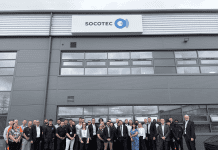The construction industry continues to face a myriad of challenges in 2024: recruitment gaps, sustainability concerns and an ongoing need to improve worker safety. Dave Walsha, sales manager at drive system supplier EMS, explains why the adoption of robotics could provide a resolution
While robotics continues to transform the industrial and automotive sectors, there’s one industry within which it’s yet to make widespread progress: construction.
However, making use of robotics and automation could be the solution to many of the challenges currently faced by the sector.
Overcoming staffing shortages through a safer, more efficient workplace
Filling in skills gaps is one example of how robotics might be used to benefit construction companies. Consultancy firm Pagabo found that some 92 per cent of construction firms are struggling to recruit the right talent.
Specialist skills like welding are in dwindling supply, and as more employees begin to reach retirement age, there’s concern that there isn’t enough fresh talent entering the industry to meet future demands.
Here, robots could step in to make up for some of the worker shortfall. Monotonous and repetitive jobs, such as simple welding tasks, could be automated to free up valuable time for employees. This way, there’s still the opportunity for human workers to use their skills for more complex tasks, but without having to do so on top of their normal workload.
But technology could even help drive recruitment to the sector. A Deconstruction report carried out with YouGov in 2023 found that 69 per cent of UK adults would not consider a career in construction. And that percentage increases to 77 when the same question was asked to full-time students between the age of 18 and 24. When asked to select words and phrases that they associated with the construction industry, 70 per cent selected ‘strenuous’, 52 per cent selected ‘dirty’ and a quarter selected ‘unsafe’.
Evidently, it’s clear that the sector needs a makeover if it’s to change wider perceptions and encourage more people to pursue a career in construction. Removing some of these concerns around physical stress and safety could be possible with a wider implementation of technology, including robotics and drones. Not only will this boost recruitment, but it can also help to retain employees.
Construction robotics could be deployed in hazardous environments without risk
Closely linked to improving retention and recruitment is safety. And here, robotics offer further advantages. Hazardous environments, such as those with harmful chemicals like asbestos, are ideal for robot deployment.
To protect against asbestos dust, workers will typically need to wear protective suits and masks. But these can restrict movement and be uncomfortable to wear for long periods. Furthermore, exposure rules dictating how long employees can work with asbestos per day can mean that for large-scale projects, asbestos removal is a costly and time-consuming process.
Instead, asbestos experts could look to utilise robotics technology. Opting for a remotely operated solution means that the health risk posed to employees is averted, while still making use of their expertise to control and manipulate the robot to remove asbestos panelling safely.
Mitigation against fall risks is also possible with these robots. Out of all fatal falls reported across industry, more than half of these are attributed to the construction sector. And the risk is amplified when working offshore in the oil and gas industries, where ladders and walkways can be greasy, icy or wet. Implementing robots instead of humans is far safer in these high-risk environments.
Doing the dirty work in recycling
Robotics could also be beneficial for construction waste recycling. It’s estimated that 32 per cent of our landfill waste comes from building construction and demolition.
Sorting through waste manually is a time-consuming and arduous process, often putting workers at risk of contaminated or otherwise hazardous objects, such as extremely sharp materials.
Automating the process can help construction companies cut the amount of waste they send to landfill while increasing their recycling for more sustainable business operations.
Why the delay in widespread adoption of construction robotics?
While there are use cases for robotics within a construction setting, there’s still clearly a lag in adoption. Data presented in 2022 at the Big 5 Global, one of the largest events in construction industry, estimated that 98.8 per cent of work carried out in the industry was performed solely by humans.
It might be surprising that, given the challenges faced by the construction industry, there’s been little progress in successfully implementing alternative, autonomous methods. But it’s the construction processes themselves that are often a huge barrier to robotic adoption.
Manufacturing plants, for example, are often very standardised. They will typically work on very specific tasks and are either fixed in position or only move within a limited space.
However, on-site construction doesn’t meet these attributes. There’s little task or environmental standardisation across different building projects. And with sites often playing host to a number of staff and heavy machinery, a robot with no set path could easily get in the way.
As a result, construction managers are left with a range of questions: How will they transport the robot to the site? Can it manoeuvre across varying terrains? Will it fit onto lifts? How will it interact with other workers on the plant?
Dedicated design will enhance the robot’s abilities
So, what can robot manufacturers do to address these questions? It’s clear that advancements will need to be made in more than one area to deliver intelligent, dexterous robots.
This includes more sophisticated sensing capabilities. For a robot to successfully navigate around the construction site on its own and avoid surrounding objects, robots must have more sophisticated object recognition powered by onboard sensors to safely move around. These may be visual sensors using regular cameras and image processing technology, or Light Detection and Ranging (LiDAR), using near-infrared light.
A team at Monash University in Australia is attempting to build more sophisticated image recognition robots, using images to train AI to recognise different materials in construction site waste. Its AI system is now able to categorise materials more quickly than humans, allowing for recyclables such as wood and glass to be collected safely.
Choosing the right DC motor technology
As projects are ongoing to improve the ‘thinking’ capabilities of the robot, what can be done about the physical? To improve the functionality of the robot, we need to take a closer look at the underlying motor technology. A robot may contain any number of small DC motors, depending on the extent and range of movement required.
Since the range of tasks on any construction site can vary widely, it’s imperative that the robot is designed to accommodate for these. For example, a robot tasked with picking up and placing objects will need a strong enough grip to hold it securely without damaging the material. In contrast, a robot tasked with hole-drilling or screwing won’t need as much dexterity, but needs more precision to ensure the work is carried out accurately.
But there are some attributes that will be universally required across construction robotics, including robustness. With dirt, dust and debris common across working sites, the motor must have the appropriate sealing to protect itself from harm.
Therefore, it’s important that construction robot manufacturers select their drive system components wisely. Advancements in motor technology mean that DC motors are lighter and more powerful than ever before. But for the optimum performance, motor selection must be done with consideration to the end application.
For example, tasks like welding will benefit from a high precision motor technology. Stepper motors are an ideal choice here. Rather than a classic DC motor, which rotates continuously, stepper motors move in tiny increments of a full rotation. These small increments are referred to as ‘steps’ and are what give stepper motors their name. The benefit of this step-by-step movement is that it allows for extremely high positional accuracy, ideal for intricate work.
Where speed takes priority, a standard brushless DC motor might be preferred. These motors can produce a stable torque at low, medium, and high speeds, providing enough power to lift and transport heavy objects.
It’s clear that the construction sector is ready for a change. If it’s to attract the talent needed to keep the industry running smoothly, it must look to follow other sectors with embracing technology. Robotics driven by DC motors will be central to modernising the sector, reimagining construction for the public and helping construction companies build more in less time with no compromise to quality.





![[VIDEO] Local planning inspector recruitment to begin in earnest in new year A drive to recruit local planning inspectors will begin in the new year](https://www.pbctoday.co.uk/news/wp-content/uploads/2025/12/iStock-2159482095-2-218x150.jpg)








